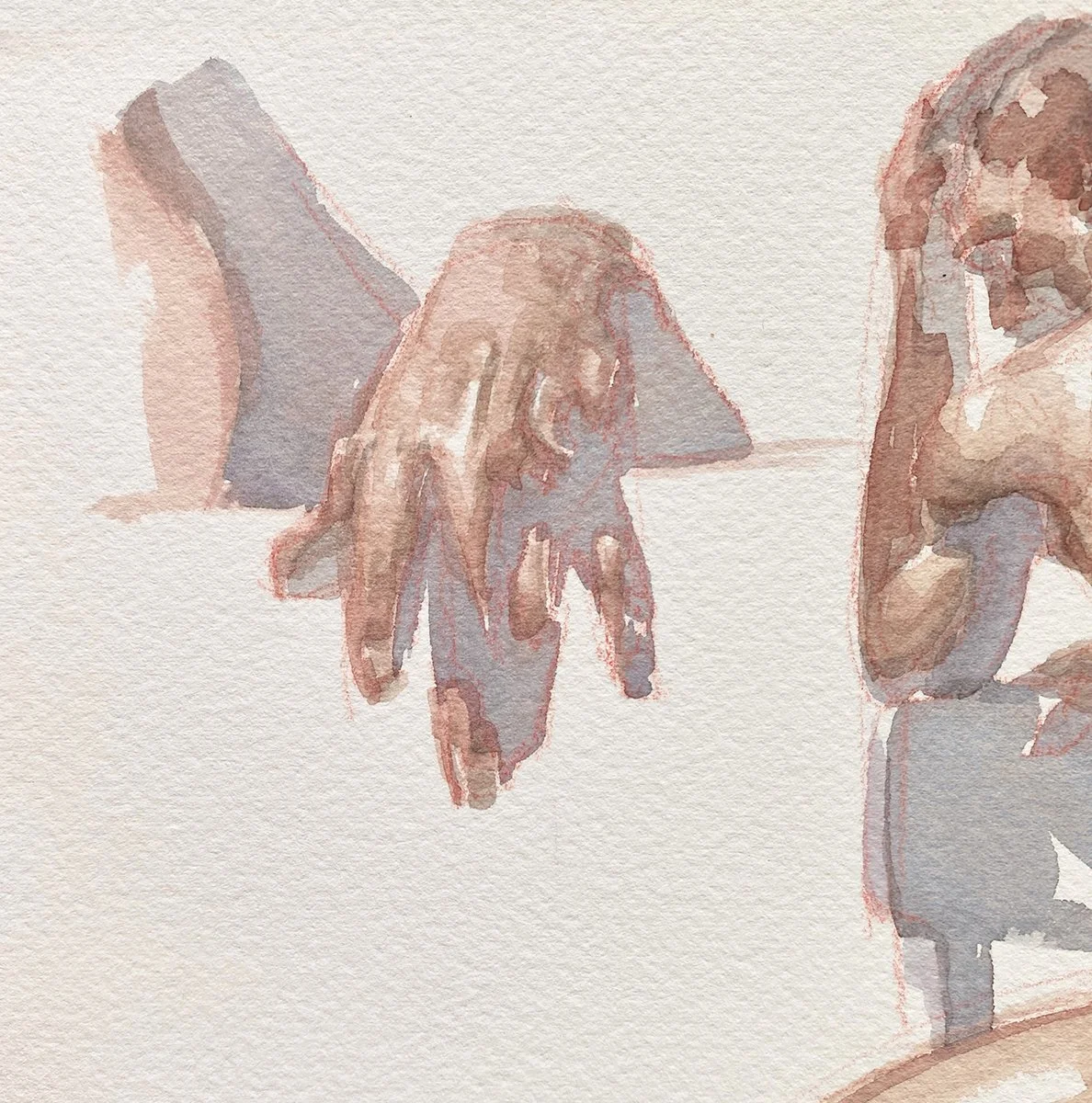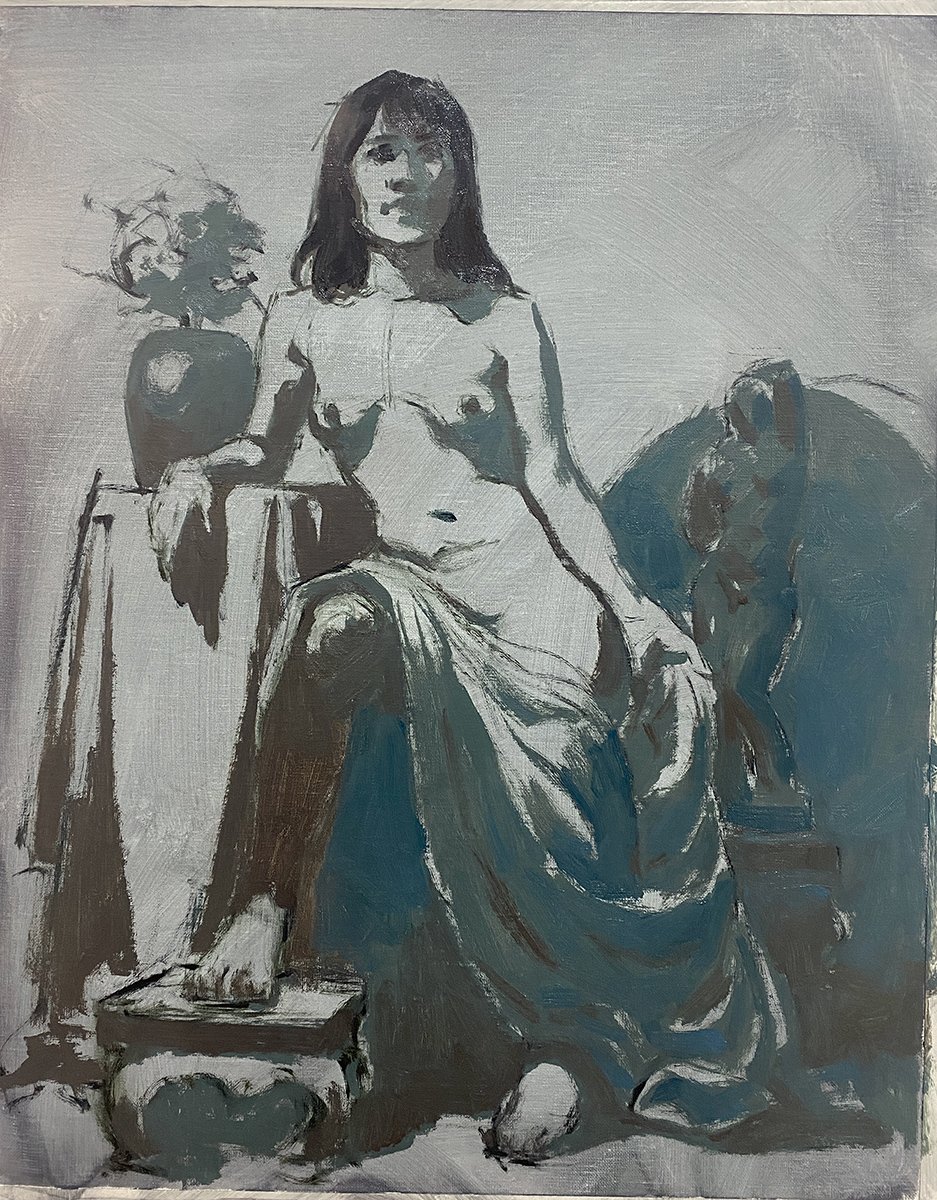Why Western Academic Realism Is the Most Beautiful Art Form
[Note from me]
Dear reader, this article began as a personal letter to the Thai students and artists I work with each week here in my home base of Bangkok. While it’s written with them in mind, I believe the message and lessons will resonate with anyone who values beauty, realism, and classical art.
[ มีภาษาไทยให้บริการครับ เลื่อนลงด้านล่างได้เลยครับ 👇 ]
Hi all,
Yesterday’s life drawing session reminded me of something important, and I want to share it with you, especially my Thai students and fellow artists here in Bangkok. It’s a simple but powerful truth:
Western Academic Realism is the most beautiful art form in the world.
At Saturday’s session (Nov 8), I sketched the model in watercolor during the longer poses. I felt this one had some success, and it inspired this message.
What do you see here?
During the model’s break, several people said:
“Wow, look at the detail…”
“It looks so realistic.”
But here’s the truth…
If you look closely, there’s no real detail. It’s not even a hand at all.
And that’s the beauty of Academic Realism.
What I practice (and teach) is the American version of this tradition, passed down from the European masters. These artists discovered something revolutionary: realism is not about copying reality. It’s about creating the illusion of reality.
They learned to draw and paint the way we see, not the way things are.
The human eye doesn’t see detail everywhere. It sees light, shadow, and contrast. So as artists, we don’t need to draw every wrinkle, muscle, hair or vein. We create the perception of detail by controlling shape, value, and edges.
That’s what makes realism powerful and beautiful.
Look again at the hand. The shadows are completely empty—just quiet, clean masses. But that emptiness is what creates the illusion. The viewer’s eye fills in the rest. They see a hand, even when it’s not really there. The mind does the work, and the artist gets the credit.
Here’s another example from a recent live painting:
Same idea. People commented:
“It looks so real…”
“So much detail…”
But again, the shadows are simple, flat, and clean. That empty space is what makes the illusion work.
This is what makes Academic Realism so unique. It’s not just art—it’s a science. A system of perception and optics that can be learned, practiced, and taught. And that’s what I’ve dedicated my life to doing.
It’s also why I’ve stayed in Thailand for nearly 10 years.
I believe God sent me to Professor Art, or sent him to me, to help carry this message forward. Together, we’re building a community that sees the world through this lens of beauty and form. And we’re doing our best to pass this gift on to Thai artists.
If you love this kind of art…
If you admire the work I do, or Professor Art does…
And if you feel called to this path, we hope you keep showing up. Come to life drawing. Practice at home. Stay part of this movement.
And if we haven’t met yet, I hope you come draw with us one day. If you choose this path, I promise: we’ll guide you the best we can.
If you liked this letter, comment “yes” and I’ll continue writing more in both English and Thai about Academic Realism and the classical tradition.
Thank you, and God bless.
– Chris Legaspi
สวัสดีครับทุกคน
เมื่อวานตอนวาด life drawing ผมได้ตระหนักถึงสิ่งหนึ่งที่สำคัญมาก เลยอยากแชร์กับทุกคน โดยเฉพาะกับนักเรียนและเพื่อนศิลปินชาวไทยที่อยู่กรุงเทพฯ กับผม
มันเป็นความจริงง่ายๆ แต่ทรงพลังมาก
ศิลปะแบบ Western Academic Realism คือศิลปะที่งดงามที่สุดในโลก
ในการวาดเมื่อวันเสาร์ที่ผ่านมา (8 พ.ย.) ผมสเก็ตช์นางแบบด้วยสีน้ำในช่วงโพสยาวๆ ซึ่งภาพนี้ผมรู้สึกว่าประสบความสำเร็จดี เลยเป็นแรงบันดาลใจให้เขียนข้อความนี้ขึ้นมา
คุณเห็นอะไรในภาพนี้บ้าง?
ระหว่างที่นางแบบพัก หลายคนเดินมาดูแล้วพูดว่า
“โห รายละเอียดเยอะมากเลย”
“เหมือนจริงมาก”
แต่ความจริงคือ...
ถ้าดูดีๆ จะเห็นว่าแทบไม่มีรายละเอียดเลยด้วยซ้ำ
มันไม่ใช่มือจริงๆ ด้วยซ้ำไป
และนั่นแหละคือความงามของ Academic Realism
สิ่งที่ผมฝึกและสอนอยู่ คือแนวทางของศิลปะแบบอเมริกันที่สืบต่อมาจากครูชาวยุโรป ศิลปินเหล่านี้ค้นพบสิ่งปฏิวัติวงการศิลปะอย่างหนึ่ง คือ “ความเหมือนจริงไม่ได้มาจากการลอกเลียนความจริง แต่เกิดจากการสร้างภาพลวงตาของความจริง”
พวกเขาเรียนรู้ที่จะวาดและระบายสี “ตามที่ตามองเห็น” ไม่ใช่ “ตามที่สิ่งนั้นเป็นจริงๆ”
สายตามนุษย์ไม่ได้เห็นรายละเอียดไปหมดทุกที่ เรามองเห็นเพียงแสง เงา และความต่างของโทน เพราะฉะนั้นในฐานะศิลปิน เราไม่จำเป็นต้องวาดทุกเส้น ทุกริ้ว ทุกเส้นเลือดหรือกล้ามเนื้อ เราเพียงแค่ต้อง “สร้างการรับรู้ถึงรายละเอียด” ด้วยการควบคุมรูปทรง ค่าความเข้ม และขอบเขตของน้ำหนัก
นั่นแหละคือสิ่งที่ทำให้ศิลปะแบบเหมือนจริงทรงพลังและงดงาม
ลองกลับไปดูที่มือนั้นอีกครั้ง เงาที่เห็นนั้นแทบไม่มีอะไรเลย เป็นเพียงก้อนน้ำหนักที่เรียบ สะอาด เงียบ แต่ “ความว่างนั้นเอง” ที่สร้างภาพลวงตา ทำให้ผู้ชมมองเห็น “มือ” ทั้งที่จริงๆ แล้วไม่มีมืออยู่ตรงนั้นเลย
สายตาและสมองของคนดูเติมส่วนที่ขาดไปเอง ศิลปินแค่เปิดช่องให้มันทำงาน แล้วได้รับเครดิตไปเต็มๆ
อีกตัวอย่างจาก painting สดล่าสุดของผม:
หลักการเดียวกันเลย หลายคนพูดว่า
“เหมือนจริงมาก”
“รายละเอียดเยอะมาก”
แต่ถ้าดูดีๆ เงาทั้งหมดเรียบและสะอาด ไม่มีรายละเอียดเลย
ความว่างนี่แหละที่ทำให้ภาพดูเหมือนจริง
นี่คือเหตุผลว่าทำไม Academic Realism ถึงเป็นอะไรที่ไม่เหมือนใคร มันไม่ใช่แค่ศิลปะ แต่มันคือ “วิทยาศาสตร์ของการมองเห็น” ระบบการรับรู้และการมองที่สามารถเรียนรู้ ฝึกฝน และถ่ายทอดได้
และนั่นแหละคือสิ่งที่ผมอุทิศชีวิตให้กับมัน
มันยังเป็นเหตุผลว่าทำไมผมถึงอยู่ประเทศไทยมาจะครบ 10 ปีแล้ว
ผมเชื่อว่าพระเจ้าส่งผมมาเจอ Professor Art หรือไม่ก็ส่งเขามาหาผม เพื่อให้เราช่วยกันเผยแพร่แนวทางนี้ต่อไป
เรากำลังสร้างชุมชนที่มองโลกผ่านเลนส์ของความงามและรูปทรง และเรากำลังพยายามถ่ายทอดของขวัญนี้ให้ศิลปินไทยรุ่นต่อๆ ไป
ถ้าคุณรักศิลปะแบบนี้
ถ้าคุณชื่นชมงานของผม หรือของ Professor Art
และถ้าคุณรู้สึกว่าถูกเรียกให้เดินเส้นทางนี้
ผมหวังว่าคุณจะยังคงมาร่วมกันต่อไป มาวาด life drawing ฝึกฝนที่บ้าน และอยู่ในขบวนการนี้ไปด้วยกัน
และถ้าเรายังไม่เคยเจอกัน ผมหวังว่าสักวันเราจะได้วาดด้วยกัน
ถ้าคุณเลือกเส้นทางนี้ ผมสัญญาว่า…ผมกับ Professor Art จะพยายามนำทางให้ดีที่สุด
ถ้าคุณชอบบทความนี้ คอมเมนต์คำว่า “yes” แล้วผมจะเขียนต่อในทั้งภาษาอังกฤษและภาษาไทย เกี่ยวกับศิลปะแบบ Academic Realism และแนวทางคลาสสิก
ขอบคุณครับ ขอพระเจ้าอวยพร
– คริส เลกัสปี

